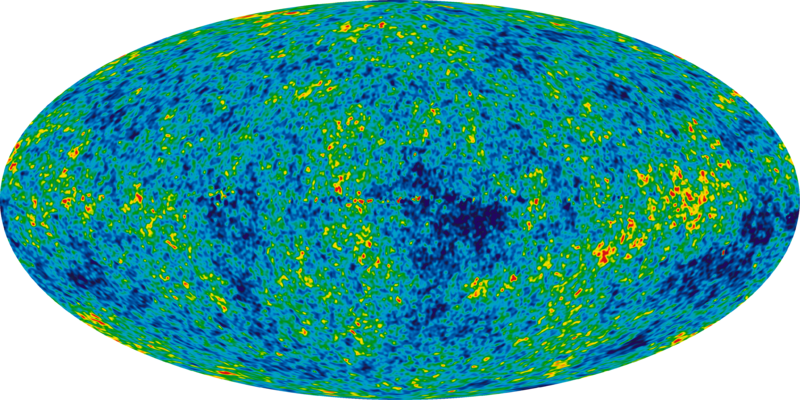That's nothing. As far as timing goes, that's a photo of the start of the Universe, give or take a bit of motion blur. Well...sort of. I'm being a little poetic, but it's the closest we can theoretically get to an honest-to-goodness photo of the Big Bang.
So yeah, it's quite impressive. It's been done before of course, it was called the WMAP (Wilkinson Microwave Anisotropy Probe) which is a very complicated way to say "Human horizon map".
As I've previously mentioned on this blog, the Universe has an horizon. It's not a two dimensional ground-sea horizon like we're used to (ie a line at a distance), it's a three dimensional horizon, a rough sphere.
And yes, it's centred on us.
That doesn't mean we're special. We're not, we're a strange lump of matter on a small bit of debris orbiting a very average star in the backwaters of a galaxy that never amounted to much.
It's just physics. The Universe has been around for 13.75 billion years, and causality travels at a certain speed. Yes, yes, yes, we call it the speed of light. That's wrong, it's a bad name and the world of science should do something about it. "c", the physical constant, is the speed of causality. Light happens to be one of the things that travels at that speed.
And all of this means that the light that left the Big Bang (or a moment after, once light actually started existing) is still out there. It's always there. It's always the-age-of-the-universe-in-light-years-away.
So all we really need to do is focus a telescope on 13.75 billion light-years, and bingo...a picture of the horizon of the Universe. (see left)
So it's no big deal, it's been done before. A few people got the wrong end of the stick and called the picture "the face of God". That's going a bit far whatever your views on theism, but if we're going to presume there is no god then this picture is the best we've got.
Well....no. Sorry. The point of science is we can do better. Sure, the WMAP picture above is impressive, but the Planck satellite's first lot of data and scientific findings have been released, and they make WMAP look a little...well, what's a nice way to say obsolete with a huge amount of affection?
So here's a picture. There's a lot of science in there, but for the moment just enjoy how pretty it is.
 |
| Image: ESA / Planck Project |
To be fair, there's a certain amount of interference. All the blue stuff for example. That's all hot dust, gas and various stars and stuff that's getting in the way...we call it the Milky Way, our galaxy. The stuff beyond that is the really interesting bit, the orange/red bits to the top left and bottom right. That's the real picture of the horizon, and there's going to be better to come once they get all that blue stuff out of the way.
And the weird oval shape? Well that's an Aitoff projection, it's simply a way of showing the sphere of the Universe all around us, but on a 2D computer screen.
If you're really clever you write a program which wraps it onto a sphere and lets you fly around inside it, observing the Universe from the Planck satellite's own point of view.
If you're not quite that clever, like me, then you write the program but you can't correct for the pixel compression at the edge of the image, so there's a big belt of distortion around the middle. And you can only make it work on Linux based computers so far.
Still, download it, give it a go, and give me a shout if it works, it's vaguely cool...
You'll need to change the permissions to make it executable ("chmod +x" or right-click the icon, properties, allow execution).
Controls: Cursor keys plus A and Z for panning/rudder.


No comments:
Post a Comment